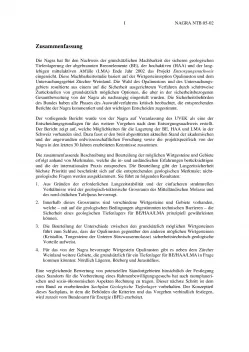
Technischer Bericht NTB 05-02
«Geologische Tiefenlagerung der abgebrannten Brennelemente, der hochaktiven und langlebigen mittelaktiven AbfälleDarstellung und Beurteilung der aus sicherheitstechnisch- geologischer Sicht möglichen Wirtgesteine und Gebiete
In order to demonstrate the basic feasibility of the safe disposal of spent fuel (SF), vitrified high-level waste (HLW) and long-lived intermediate-level waste (ILW) in a deep geological repository, Nagra has submitted Project Entsorgungsnachweis (the term translates into English as “demonstration of disposal feasibility”) at the end of the year 2002. This feasibility study is based on the Opalinus Clay host rock option in the Zürcher Weinland area in northern Switzerland. The choice of both Opalinus Clay and the Zürcher Weinland is the result of a procedure focussed on safety, in which other possible options were also evaluated but set aside by Nagra in a stepwise manner. The Swiss safety authorities have critically observed all phases of the evaluation procedure, provided comments to Nagra’s corresponding reports and have given their approval to important decisions.
The present report was put together by Nagra in response to a request by the Federal Department of Environment, Transport, Energy and Communications as a part of the decision basis for the further steps after Project Entsorgungsnachweis. The report shows which possibilities for the disposal of SF, HLW and ILW exist in Switzerland and summarises the current state of general academic and applied geoscientific research as well as the projectspecific knowledge base that has been developed by Nagra over the past 30 years.
The descriptions and assessments of the potential host rocks and areas are based on attributes that take into account experience gained both in Switzerland and abroad and are in agreement with international practice. The assessments put the highest priority on long-term safety and are restricted to the corresponding geological features. These assessments lead to the following results:
- Due to the required long-term stability and the relative simplicity of structure the preferred geologic-tectonic region is the Molasse Basin and the north-eastern Tabular Jura.
- Within this region different host rocks and areas can in principle ensure the safety of a deep geological repository for SF/HLW/ILW if the engineered barriers are adapted to the geological conditions.
- An assessment of the differences between potential host rocks leads to the conclusion that the Opalinus Clay has advantages from the geological point of view over other host rocks (crystalline basement, claystones of the Lower Freshwater Molasse).
- Opalinus Clay (the host rock preferred by Nagra) can be found in other areas besides the Zürcher Weinland which might, in principle, be appropriate for siting a SF/HLW/ILW repository. These are the areas of Nördlich Lägeren, Bözberg and Jurasüdfuss.
An assessment of potential siting areas in view of the preparation of a General Licence application will also have to consider land use planning and socio-economic aspects. This will be carried out in the next step according to the Sectoral Plan for Geological Disposal (Sachplan Geologische Tiefenlager) under the guidance of the relevant Swiss authorities. The Sectoral Strategy (Konzept) of the Plan, which defines both the relevant criteria and the procedure, is currently being developed by the Federal Office of Energy.
